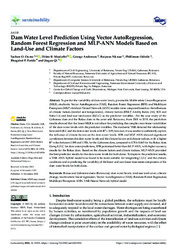Dam Water Level Prediction Using Vector AutoRegression, Random Forest Regression and MLP-ANN Models Based on Land-Use and Climate Factors.
Date
2022-11-11Author
Ouma, Yashon
Moalafhi, Ditiro
Anderson, George
Nkwae, Boipuso
Odirile, Phillimon
Parida, Bhagabat P.
Qi, Jiaguo
Metadata
Show full item recordAbstract
To predict the variability of dam water levels, parametric Multivariate Linear Regression (MLR), stochastic Vector AutoRegressive (VAR), Random Forest Regression (RFR) and Multilayer Perceptron (MLP) Artificial Neural Network (ANN) models were compared based on the influences of climate factors (rainfall and temperature), climate indices (DSLP, Aridity Index (AI), SOI and Niño 3.4) and land-use land-cover (LULC) as the predictor variables. For the case study of the Gaborone dam and the Bokaa dam in the semi-arid Botswana, from 2001 to 2019, the prediction results showed that the linear MLR is not robust for predicting the complex non-linear variabilities of the dam water levels with the predictor variables. The stochastic VAR detected the relationship between LULC and the dam water levels with R2 > 0.95; however, it was unable to sufficiently capture the influence of climate factors on the dam water levels. RFR and MLP-ANN showed significant correlations between the dam water levels and the climate factors and climate indices, with a higher R2 value between 0.890 and 0.926, for the Gaborone dam, compared to 0.704–0.865 for the Bokaa dam. Using LULC for dam water predictions, RFR performed better than MLP-ANN, with higher accuracy results for the Bokaa dam. Based on the climate factors and climate indices, MLP-ANN provided the best prediction results for the dam water levels for both dams. To improve the prediction results, a VAR-ANN hybrid model was found to be more suitable for integrating LULC and the climate conditions and in predicting the variability of the linear and non-linear time-series components of the dam water levels for both dams.
URI
https://doi.org/10.3390/su142214934https://www.mdpi.com/journal/sustainability
https://hdl.handle.net/13049/671
Collections
- Research articles [88]
Related items
Showing items related by title, author, creator and subject.
-
Effect of market participation on household welfare among smallholder goat farmers in Botswana
Ngwako, Gomolemo; Mthenge, Mary; Gido, Eric; Kgosikoma, Keneilwe (University of Life Sciences in Poznan, 2021-03-03)Goat farming is a major livelihood activity for most smallholder farmers in Botswana. To ensure sustainable livelihoods for these farmers, a shift from the prevalent traditional and subsistence system to a more market-oriented ... -
The estimation of live weight based on linear traits in indigenous Tswana goats at various ages in Botswana.
Sebolai, Boingotlo; Nsoso, Shalaulani James; Podisi, Baitse; Mokhutshwane, Bueno Shanto (Springer Link, 2011-10-02)The objective of this study was to determine the usefulness of some linear body measurements in predicting live weight in indigenous Tswana goats at various ages. Data for this study were obtained from 2,783 goats sampled ... -
Missing covariates in multiple linear regression when the data is missing at random
Nthoiwa, G.P; Owino, J.O (Botswana University of Agriculture & Natural Resources, 2008)The occurrence of missing values is frequent in data collected for different uses such as in surveys, censuses, balanced experiments. On the other end most statistical analysis methods have been developed for complete ...




